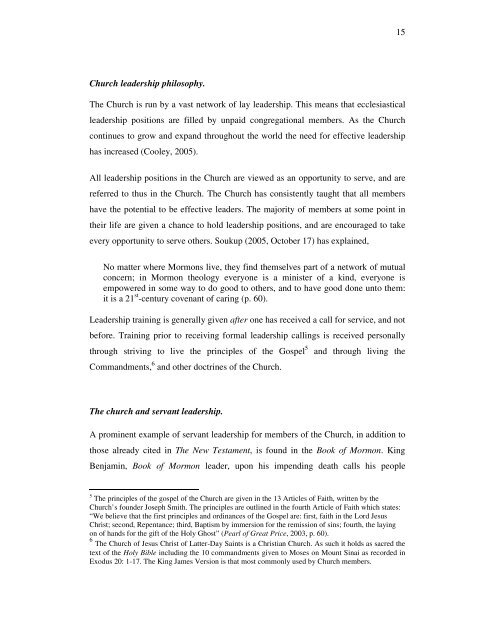nurturing servant leaders in religious education - Scholarly ...
nurturing servant leaders in religious education - Scholarly ...
nurturing servant leaders in religious education - Scholarly ...
Create successful ePaper yourself
Turn your PDF publications into a flip-book with our unique Google optimized e-Paper software.
Church <strong>leaders</strong>hip philosophy.<br />
The Church is run by a vast network of lay <strong>leaders</strong>hip. This means that ecclesiastical<br />
<strong>leaders</strong>hip positions are filled by unpaid congregational members. As the Church<br />
cont<strong>in</strong>ues to grow and expand throughout the world the need for effective <strong>leaders</strong>hip<br />
has <strong>in</strong>creased (Cooley, 2005).<br />
All <strong>leaders</strong>hip positions <strong>in</strong> the Church are viewed as an opportunity to serve, and are<br />
referred to thus <strong>in</strong> the Church. The Church has consistently taught that all members<br />
have the potential to be effective <strong>leaders</strong>. The majority of members at some po<strong>in</strong>t <strong>in</strong><br />
their life are given a chance to hold <strong>leaders</strong>hip positions, and are encouraged to take<br />
every opportunity to serve others. Soukup (2005, October 17) has expla<strong>in</strong>ed,<br />
No matter where Mormons live, they f<strong>in</strong>d themselves part of a network of mutual<br />
concern; <strong>in</strong> Mormon theology everyone is a m<strong>in</strong>ister of a k<strong>in</strong>d, everyone is<br />
empowered <strong>in</strong> some way to do good to others, and to have good done unto them:<br />
it is a 21 st -century covenant of car<strong>in</strong>g (p. 60).<br />
Leadership tra<strong>in</strong><strong>in</strong>g is generally given after one has received a call for service, and not<br />
before. Tra<strong>in</strong><strong>in</strong>g prior to receiv<strong>in</strong>g formal <strong>leaders</strong>hip call<strong>in</strong>gs is received personally<br />
through striv<strong>in</strong>g to live the pr<strong>in</strong>ciples of the Gospel 5 and through liv<strong>in</strong>g the<br />
Commandments, 6 and other doctr<strong>in</strong>es of the Church.<br />
The church and <strong>servant</strong> <strong>leaders</strong>hip.<br />
A prom<strong>in</strong>ent example of <strong>servant</strong> <strong>leaders</strong>hip for members of the Church, <strong>in</strong> addition to<br />
those already cited <strong>in</strong> The New Testament, is found <strong>in</strong> the Book of Mormon. K<strong>in</strong>g<br />
Benjam<strong>in</strong>, Book of Mormon leader, upon his impend<strong>in</strong>g death calls his people<br />
5 The pr<strong>in</strong>ciples of the gospel of the Church are given <strong>in</strong> the 13 Articles of Faith, written by the<br />
Church’s founder Joseph Smith. The pr<strong>in</strong>ciples are outl<strong>in</strong>ed <strong>in</strong> the fourth Article of Faith which states:<br />
“We believe that the first pr<strong>in</strong>ciples and ord<strong>in</strong>ances of the Gospel are: first, faith <strong>in</strong> the Lord Jesus<br />
Christ; second, Repentance; third, Baptism by immersion for the remission of s<strong>in</strong>s; fourth, the lay<strong>in</strong>g<br />
on of hands for the gift of the Holy Ghost” (Pearl of Great Price, 2003, p. 60).<br />
6 The Church of Jesus Christ of Latter-Day Sa<strong>in</strong>ts is a Christian Church. As such it holds as sacred the<br />
text of the Holy Bible <strong>in</strong>clud<strong>in</strong>g the 10 commandments given to Moses on Mount S<strong>in</strong>ai as recorded <strong>in</strong><br />
Exodus 20: 1-17. The K<strong>in</strong>g James Version is that most commonly used by Church members.<br />
15

















